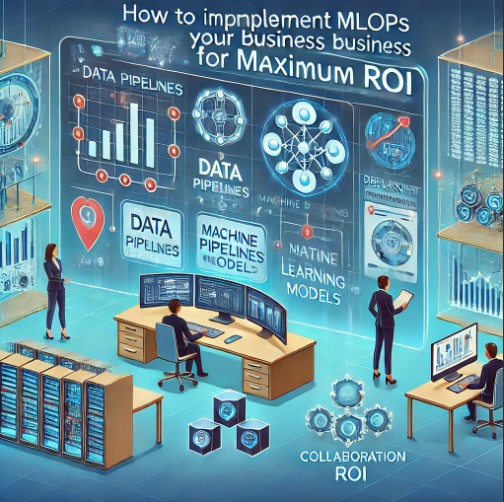Table of Contents
- 1 Introduction
- 2 What is MLOps?
- 3 Getting Started with MLOps
- 4 Advanced MLOps Practices
- 5 FAQs
- 6 Conclusion
Introduction
In the rapidly evolving field of machine learning (ML), organizations are increasingly adopting MLOps (Machine Learning Operations) to streamline and scale their ML workflows. MLOps bridges the gap between ML model development and operations, ensuring efficient deployment, monitoring, and management of ML models. This guide will help you understand how to implement MLOps in your business to maximize return on investment (ROI).
What is MLOps?
Definition and Importance
MLOps, short for Machine Learning Operations, is a set of practices that combines ML system development (Dev) and ML system operations (Ops). It aims to automate and enhance the process of deploying and maintaining ML models in production.
Benefits of MLOps
- Improved Collaboration: Facilitates better collaboration between data scientists and operations teams.
- Increased Efficiency: Streamlines model deployment and management, reducing time to market.
- Scalability: Enables the scaling of ML models across various environments.
- Enhanced Monitoring: Provides robust monitoring and management tools to ensure model performance and reliability.
Getting Started with MLOps
1. Establishing a Solid Foundation
Understanding Your Business Needs
Before diving into MLOps, it’s crucial to understand your business objectives and how ML can help achieve them. Identify key areas where ML models can provide value and outline clear goals for their implementation.
Building a Cross-Functional Team
Assemble a team that includes data scientists, ML engineers, software developers, and operations professionals. This cross-functional team will ensure that all aspects of the ML lifecycle are covered, from model development to deployment and maintenance.
2. Implementing the Right Tools and Technologies
Version Control Systems
Implement version control systems like Git to manage code, model versions, and data changes. This ensures that all team members can collaborate effectively and track changes over time.
Containerization
Use containerization technologies like Docker to package and deploy ML models consistently across different environments. Containers ensure that the models run reliably, regardless of where they are deployed.
Continuous Integration and Continuous Deployment (CI/CD)
Set up CI/CD pipelines to automate the process of building, testing, and deploying ML models. Tools like Jenkins, GitLab CI, and CircleCI can help streamline this process.
3. Data Management and Preprocessing
Data Ingestion
Implement robust data ingestion pipelines to collect and preprocess data from various sources. Ensure data quality and consistency to build reliable ML models.
Data Versioning
Use tools like DVC (Data Version Control) to manage and version datasets. This enables tracking of data changes and ensures reproducibility of ML experiments.
4. Model Training and Validation
Experiment Tracking
Implement experiment tracking tools like MLflow or Weights & Biases to log and track ML experiments. This helps in comparing different models and selecting the best-performing ones.
Hyperparameter Tuning
Perform hyperparameter tuning to optimize model performance. Use techniques like grid search, random search, or Bayesian optimization to find the best hyperparameters.
5. Model Deployment and Monitoring
Deployment Strategies
Choose the right deployment strategy based on your business needs. Options include:
- Batch Inference: Processing large batches of data at scheduled intervals.
- Real-Time Inference: Making predictions in real-time as data arrives.
- Hybrid Inference: Combining batch and real-time inference for different use cases.
Monitoring and Logging
Implement monitoring and logging tools to track model performance in production. Tools like Prometheus and Grafana can help monitor key metrics and alert you to any issues.
Advanced MLOps Practices
1. Model Retraining and Lifecycle Management
Automated Retraining
Set up automated retraining pipelines to update models with new data regularly. This ensures that models remain accurate and relevant over time.
Model Governance
Implement model governance practices to manage model versions, ensure compliance, and track model lineage. This includes maintaining detailed documentation and audit trails.
2. Explainability and Fairness
Model Explainability
Use tools like SHAP or LIME to explain model predictions. This helps in building trust with stakeholders and ensures transparency in ML models.
Fairness and Bias Mitigation
Implement fairness checks to identify and mitigate biases in ML models. Ensure that models are fair and do not discriminate against any group.
3. Security and Compliance
Data Security
Ensure that data is securely stored and transmitted. Implement encryption, access controls, and other security measures to protect sensitive information.
Regulatory Compliance
Stay compliant with relevant regulations and standards, such as GDPR, HIPAA, or CCPA. Ensure that your MLOps practices adhere to these requirements.
FAQs
What are the key components of MLOps?
The key components of MLOps include version control, CI/CD pipelines, containerization, experiment tracking, monitoring, and automated retraining.
How does MLOps improve collaboration between teams?
MLOps fosters collaboration by creating a shared workflow and tools that allow data scientists, ML engineers, and operations teams to work together seamlessly.
What are some common challenges in implementing MLOps?
Common challenges include managing data quality, scaling ML models, ensuring model explainability, and staying compliant with regulations.
How can MLOps help in scaling ML models?
MLOps enables the scaling of ML models through automation, robust monitoring, and efficient deployment strategies, ensuring that models can handle increased workloads.
What tools are commonly used in MLOps?
Commonly used tools in MLOps include Git for version control, Docker for containerization, Jenkins for CI/CD, MLflow for experiment tracking, and Prometheus for monitoring.

Conclusion
Implementing MLOps in your business can significantly enhance the efficiency and scalability of your ML workflows, leading to maximum ROI. By following the best practices outlined in this guide, you can ensure that your ML models are deployed, monitored, and maintained effectively. Embrace MLOps to stay competitive in the rapidly evolving field of machine learning and achieve your business goals. Thank you for reading the DevopsRoles page!
